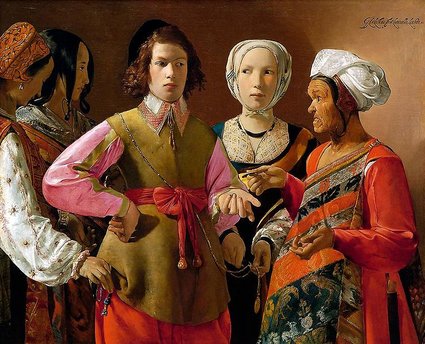Georges de La Tour was born March 14, 1593 in Vic-sur-Seille in Lorraine, France. There were no historical records that transcribe the earlier life of de La Tour not until he was twenty-four, which meant that a decade of his significant life was missed. George de La Tour married Diane le Nerf in 1617 and raised 10 children. He moved to Luneville where he spent the rest of his life. Some of the people who knew him describe him as “a basically unpleasant person – haughty, sharp-tongued, self-assured, unbearably self-sufficient, stingy, and violent beyond measure” but despite the negative notions against him, he was able to stand as a master painter with extreme ideas during the duration of his painting career. German art historian Hermann Voss rediscovered de La Tour’s painting thus his reign as one of the great painters of all time.
His painting The Fortune Teller is an oil-on-canvas painting made circa 1630. The Metropolitan Museum of Art in New York purchased it with a calligraphic signature on the top right shown as “G. de La Tour Fecit Luneuilla Lothar”, which means “Georges de La Tour made this”. Lorraine Luneville, an English historian, questioned the authenticity of the painting but later on was proven as de La Tour’s art paint. De La Tour is known for his chiaroscuro techniques with a hint of religious compositions in which the subjects are lighted up from a single source of light but the intricacies of costume were not brilliantly emphasized. The Fortune Teller painting portrays a wealthy young man who had his fortune foretold by an old fortune teller woman. The portrait also shows the old woman picking up the coin from the hand of the young man, as payment and at the same time a gesture which signifies a ritual. The other women present in the painting are gypsies who were considered as thieves during that era. It clearly shows the women in the background stealing some coins and personal possession from the wealthy young man. The painting as a whole is considered to be a theatrical scene of deceit and theft.
The painting technique of Georges de la Tour is unique in the sense that it captures the depiction of a common theme the same with design and composition. De la Tour was known to be a follower of Caravaggio, thus influenced with the Caravaggesue style particularly using chiaroscuro and tenebristic techniques. De la Tour as a realist avoided naturalism; he rather simplified his subjects with marked contrast of light and shade and at the same time maximizing volume and severe lines with selective details. He specialized in the use of lighting and nocturnal scenes in a way that it defined the message of his painting without degrading the entirety of the theme.
George de la Tour’s style of making his paintings based on his moods gave a meditative or pensive quality that no other painter produced. He focused on how the painting would affect his viewer’s emotions rather than the literal elements of the whole piece. He illustrated his works through his varying moods. De La Tour’s history was not as substantial compared to the other great painters but despite the missing stories and milestones of his life, he was still a big influence to succeeding painters in history.
Author: Shyxter
